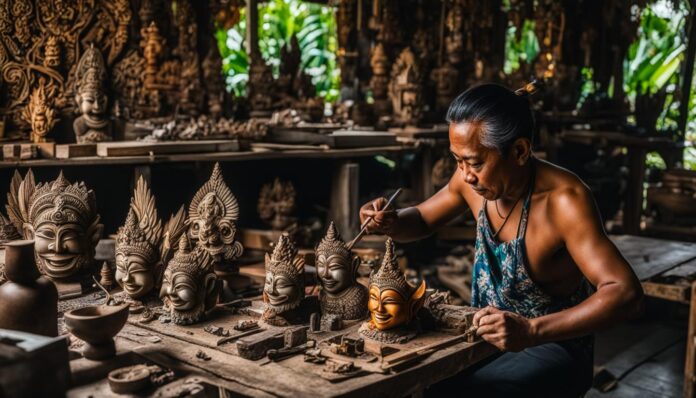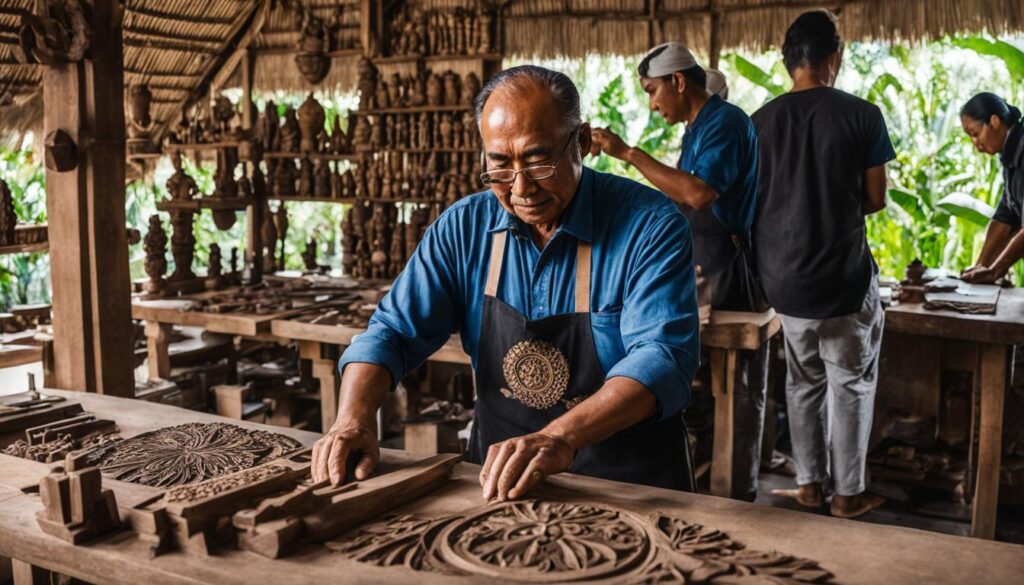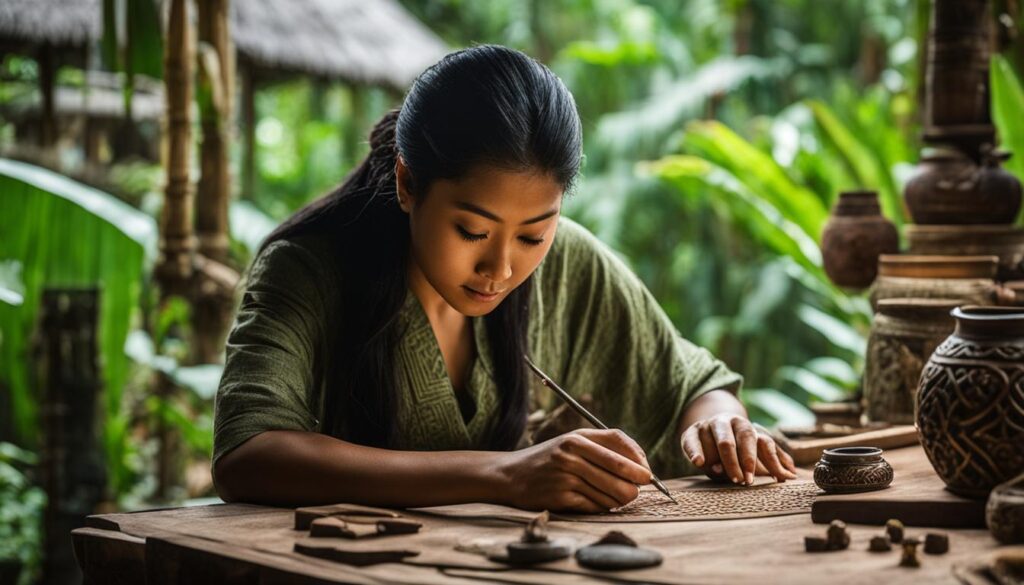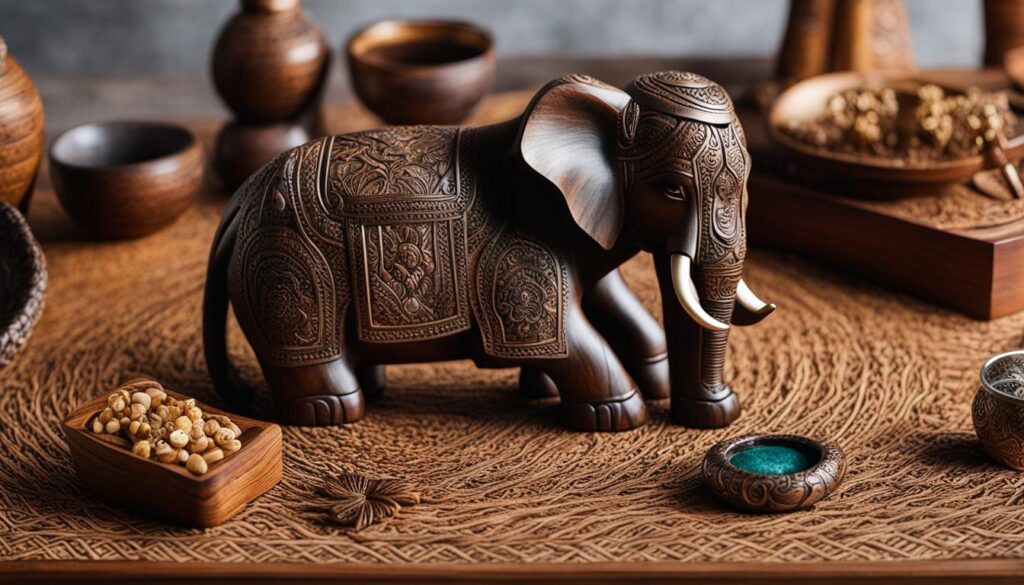Get ready to immerse yourself in the vibrant arts scene of Bali, where local crafts and workshops like woodcarving and silver jewelry making await. Bali is renowned for its rich cultural heritage and world-class craftsmanship, offering visitors a unique opportunity to witness traditional art forms in action and learn new skills from local artisans.
Explore Bali’s local crafts, from traditional woodcarvings to stunning silver jewelry, and gain insights into the cultural significance behind each craft. In this section, we will introduce you to the beauty of Bali’s local crafts and the workshops where you can learn traditional skills like woodcarving and silver jewelry making.
Discover the hands-on experience and cultural exchange that these workshops offer, and learn from the experts who have mastered their craft over generations. Whether you are a seasoned artist or a curious traveler, Bali’s local crafts and workshops are sure to captivate your senses and awaken your creativity.
Bali Local Crafts: A Reflection of Traditional Art
Discover the rich cultural heritage of Bali through the local crafts that reflect its traditional art forms. Balinese handicrafts are known for their intricate designs and skilled craftsmanship that have been passed down through the generations of local artisans Bali. These traditional crafts Bali are not only beautiful but deeply meaningful, rooted in the island’s unique cultural identity.
Through cultural workshops Bali, visitors have the opportunity to learn from Balinese artisans and gain a deeper understanding of the significance behind each craft. Local workshops offer hands-on experiences that allow you to immerse yourself in the creative process and learn from the masters themselves.
From woodcarving Bali to silver jewelry making Bali, these local artisans Bali create stunning pieces that embody the spirit of Balinese art. The traditional techniques and motifs used in each craft showcase the unique talents and creativity of the local artisans. Each piece tells a story and reflects the rich cultural heritage that has inspired generations of Balinese craftsmen and women.
| Traditional Crafts Bali | Balinese Handicrafts | Local Artisans Bali | Cultural Workshops Bali |
|---|---|---|---|
| Woodcarving Bali | Batik | Painters | Woodworking Bali |
| Silver Jewelry Making Bali | Wayang Kulit | Weavers | Silver Jewelry Making Bali |
| Stone Carving Bali | Ikat Weaving | Ceramicists | Textile Printing Bali |
| Painting Bali | Bamboo Crafting | Woodcarvers | Gamelan Making Bali |
Table: Examples of Traditional Crafts and Art Forms in Bali
Exploring Bali’s craft villages can further deepen your appreciation for these traditional crafts Bali. Places like Mas Village for woodcarving and Celuk Village for silver jewelry making offer a unique opportunity to witness the artisans in action and learn about their techniques and traditions.
By supporting local artisans and engaging in ethical shopping practices, you can help preserve Bali’s artistic heritage for future generations. There are organizations and initiatives dedicated to promoting and protecting traditional crafts, so consider getting involved or supporting these efforts.
Woodcarving Bali: A Time-Honored Craft
Bali’s woodcarving tradition dates back centuries, and it remains an important part of the island’s cultural heritage. The intricate carvings adorning temples, shrines, and even everyday objects like furniture and utensils are a testament to the skill and artistry of Balinese woodcarvers.
The craft has evolved over the years, with traditional techniques being passed down through generations of Balinese artisans. Today, visitors can witness the woodcarving process up close in workshops throughout Bali, where local artisans demonstrate their skill and share their knowledge.
History and Techniques
The history of woodcarving in Bali is intertwined with the island’s religious and cultural practices. Carved wooden objects were used in religious ceremonies and offerings, and the craft was also employed in the creation of palaces and other important structures.
Balinese woodcarving is characterized by elaborate designs and precise attention to detail. Utmost care is given to choosing the right wood, as it has a significant impact on the final carving. Once the wood is selected, the carver sketches the design on the surface, and then uses a combination of chisels and knives to carve the wood.
Styles and Motifs
Balinese woodcarving features a variety of styles and motifs, each with its own meaning and symbolism. One of the most common styles is the Barong, a mythical creature that represents good triumphing over evil.
The Garuda, a bird-like creature from Hindu mythology, is also a popular motif in Balinese woodcarving. It represents power and strength and is often depicted with its wings spread wide.
Other popular motifs include lotus flowers, dragons, and scenes from Balinese mythology.
Cultural Workshops
Visitors to Bali can experience firsthand the art of woodcarving by visiting cultural workshops throughout the island. These workshops offer a unique opportunity to learn from local artisans and gain insights into the history and techniques of Balinese woodcarving.
Whether you’re a novice or an experienced carver, these workshops allow you to immerse yourself in Bali’s rich culture and take home a piece of the island’s artistic heritage.
Silver Jewelry Making Bali: From Raw Materials to Stunning Pieces
One of the most fascinating traditional crafts in Bali is silver jewelry making. Balinese artisans have been producing stunning pieces of silver jewelry for centuries, and the art has evolved over time to take on unique Balinese styles and motifs.
The process of creating silver jewelry in Bali involves melting down silver and shaping it into intricate designs. The metal may be embellished with precious gemstones or intricate carvings, showcasing the skill and craftsmanship of the artisans.
Visitors to Bali can gain insights into this traditional craft by visiting one of the many workshops that offer hands-on experiences in silver jewelry making. During these workshops, you can learn about the traditional techniques used by Balinese artisans. You can also create your own pieces of custom-made jewelry to take home as a unique souvenir.
Symbolism plays an important role in Balinese silver jewelry designs. For instance, some designs incorporate patterns inspired by Balinese mythology, while others use motifs such as the lotus flower or sacred bird. The symbolism behind each design adds a layer of depth to each piece, making it truly unique and meaningful.
The Significance of Balinese Handicrafts in Bali’s Cultural Heritage
Traditional crafts like silver jewelry making are an important part of Bali’s cultural heritage. These crafts reflect the island’s artistic traditions and the skills that have been passed down through generations of Balinese artisans.
By learning about and practicing these crafts, visitors can gain a deeper understanding of Bali’s cultural heritage while supporting local artisans and their livelihoods. Silver jewelry making workshops offer a unique and immersive experience where visitors can create their own custom-made jewelry while gaining new skills and insights into Balinese culture.
Workshops: Learn from Local Artisans
Visiting Bali’s workshops is an opportunity to immerse yourself in the rich heritage and cultural exchange with local artisans. You can learn the traditional skills of woodcarving Bali and silver jewelry making Bali directly from experts in the field. Many workshops offer hands-on experiences, where you can create your woodcarving or silver jewelry under the instruction of local artisans. Not only will you gain valuable skills, but you’ll also learn about the cultural significance behind each craft.
Local artisans Bali are happy to share their knowledge with visitors and are excited to teach you about their craft. You’ll have a unique opportunity to ask questions and explore the techniques they use to create stunning pieces. By visiting Bali workshops, you can improve your skills in woodcarving Bali or silver jewelry making Bali and further support the preservation of these traditional crafts.
Attending a workshop is also an opportunity for cultural exchange. You’ll gain insights into the daily life of local artisans Bali and develop a deeper appreciation for their craft. By participating in a workshop, you’ll be supporting the local community and contributing to the preservation of traditional art forms in Bali.
Exploring Bali’s Craft Villages
One of the must-visit places in Bali is its craft villages, where you can witness traditional crafts being made by skilled local artisans. These villages are known for producing some of Bali’s finest handicrafts and are home to generations of craftsmen who have passed down their skills over the years.
One of the most famous of these villages is Mas Village, located just outside of Ubud. Mas Village is known for its intricate woodcarving, and visitors can watch craftsmen at work, creating beautiful wooden sculptures and decorative pieces. Another notable village is Celuk Village, where you can witness the art of silver jewelry making. Here, skilled artisans melt, shape, and embellish silver to create stunning pieces of jewelry.
Exploring these craft villages is a unique way to experience Bali’s rich culture and learn about its traditional crafts. Watching the artisans at work is an incredible experience and gives visitors a deeper appreciation for the time, skill, and artistic vision required to create these beautiful pieces.
Supporting Local Artisans: Ethical Shopping in Bali
When visiting Bali, you have the opportunity to support the local community and the preservation of traditional crafts by engaging in ethical shopping practices. By purchasing handcrafted items from Bali local craftspeople, you are not only taking home a unique and authentic piece of Balinese handicrafts, but you are also providing support to the local workforce.
Shopping for local crafts in Bali is a great way to connect with the culture and community of the island. By visiting local markets and shops, you can meet the Balinese artisans who create these one-of-a-kind pieces and learn about the cultural significance behind their crafts.
When shopping for Bali local crafts, it’s important to be mindful of ethical standards. Be wary of mass-produced items that are made outside of Bali and sold as “authentic” items. Instead, look for certified local artisans Bali, who use traditional techniques and materials to create unique and high-quality products.
Opting for ethically sourced items also helps to support the livelihood of the local artisans. By choosing to buy directly from them, you ensure that your money goes straight into the hands of those who created the item. In turn, this helps to maintain the economic stability of the local community, making it possible for future generations to continue these traditional crafts.
When deciding what to buy, consider purchasing items that are both visually appealing and carry cultural significance. Balinese handicrafts such as woodcarving and silver jewelry making Bali, are deeply rooted in the island’s heritage and will add a unique touch to your home or wardrobe.
“When you purchase a traditional Bali handicraft, you are not just buying a beautiful piece of art, you are also investing in the preservation of Balinese tradition”
By supporting local artisans and ethical shopping practices in Bali, you can contribute to the preservation of traditional crafts while also taking home a unique memento of your visit.
Preserving Bali’s Artistic Heritage: Organizations and Initiatives
Bali has a deep-rooted tradition of local crafts, and many organizations and initiatives are working hard to preserve the island’s artistic heritage. These organizations and initiatives are dedicated to promoting and protecting traditional crafts and providing opportunities for local artisans.
One such organization is the Bali Creative Industry Center (BCIC), which aims to develop traditional crafts and create jobs for locals. BCIC offers training and development programs for artisans, as well as workshops and events that promote traditional crafts and skills.
Another initiative is the Bali Traditional Art Market, which provides a platform for local artisans to showcase and sell their products. The market features a wide range of traditional crafts, including woodcarvings, textiles, and silver jewelry.
The Bali Cultural Workshop is another organization that offers workshops and classes in traditional crafts like woodcarving, silver jewelry making, and painting. The workshops are conducted by local artisans who are experts in their craft, providing a unique opportunity for visitors to learn directly from the source.
Preserving Bali’s artistic heritage is critical to maintaining the island’s cultural identity and providing a livelihood for local artisans. By supporting these organizations and initiatives, you can help ensure the future of Bali’s traditional crafts.
Beyond Crafts: Other Cultural Experiences in Bali
While woodcarving and silver jewelry making are some of the most popular traditional crafts in Bali, the island is also home to a wealth of other artistic expressions that are worth exploring during your visit. Take a look at some of the traditional art forms that Bali has to offer:
Painting
Bali has a strong tradition of painting, with styles ranging from traditional to modern and contemporary. You can see exquisite paintings and intricate designs in galleries or even in the streets of Ubud, known as the cultural capital of Bali. Balinese painting often uses vivid colors and intricate details to capture the island’s natural beauty, cultural traditions, and mythological stories.
Weaving
Weaving is another traditional art in Bali, with a long history of producing fine textiles and intricate patterns. The fabrics produced in Bali can be used for clothing, wall hangings, and accessories. In Ubud and surrounding villages, you can find weaving workshops and studios that showcase the traditional techniques used by Balinese women to create these beautiful textiles.
Woodworking
Besides woodcarving, Bali is also known for woodworking. The island’s artisans use their skills to create beautiful pieces of furniture, intricate masks, and decorative items. You can find stunning wooden furniture in Bali’s many furniture workshops, where you can see the intricate carving techniques used to produce these elegant pieces.
Table: Other Traditional Art Forms in Bali
| Art Form | Description |
|---|---|
| Wayang Kulit | A form of shadow puppetry that tells stories from the Hindu epics like Ramayana and Mahabharata. Wayang performances usually take place at night and are accompanied by a gamelan orchestra. |
| Stone Carving | Bali’s artisans also use their skills to create intricate stone carvings that can be found in temples, palaces, and other public spaces. The stone sculptures often depict mythical creatures, deities, and scenes from Hindu epics. |
| Mask Making | Balinese masks are used in dance performances, ceremonies, and other cultural events. The masks are often carved from wood or bone and painted with bright colors and intricate designs. |
If you’re interested in exploring these traditional art forms, Bali has many cultural workshops, museums, and galleries where you can learn from local artisans and gain a deeper appreciation of the island’s rich cultural heritage.
Conclusion
You’ve learned about the beauty of Bali’s local crafts and the workshops where you can learn traditional skills like woodcarving and silver jewelry making. Through these traditional art forms, Bali’s cultural heritage is reflected, and you’ve discovered the intricate craftsmanship and artistic techniques employed by Balinese artisans.
By exploring these crafts and workshops, you can gain a deeper understanding of the cultural heritage that inspires them. You can witness the unique styles and motifs used in Balinese woodcarving and the symbolism behind the designs in silver jewelry making.
During your visit to Bali, you’re encouraged to explore the craft villages known for their traditional crafts, engage in ethical shopping practices, and support local artisans. Additionally, beyond crafts, you can discover other cultural experiences in Bali such as painting, weaving, and woodworking.
By indulging in these immersive cultural experiences, you can preserve Bali’s artistic heritage and gain a better appreciation for the island’s vibrant arts scene. So go ahead, explore Bali’s local crafts and workshops, and infuse your visit with cultural significance and artistic flair.
















































